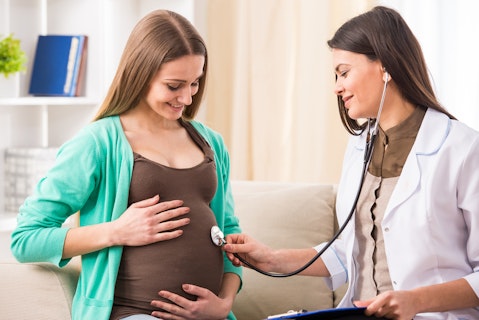In this article, we will be taking a look at the 25 countries with highest abortion rates. If you do not want to learn about the global pregnancy care products market, head straight to the 5 Countries With Highest Abortion Rates.
The prevalence of abortion rates varies significantly across nations, shedding light on complex socio-political, cultural, and healthcare dynamics worldwide. Delving into countries with the highest abortion rates like India, Pakistan, and Cambodia, among others, unveils a multifaceted landscape, where factors such as access to contraception, legal frameworks, socio-economic disparities, and cultural attitudes towards reproductive rights intersect to shape outcomes. Understanding the nuances of these nations not only provides insight into the global reproductive health landscape but also underscores the importance of comprehensive policies and support systems to address the diverse needs of individuals facing unplanned pregnancies.
The Growth Trajectory of the Global Pregnancy Care Products Market
The global pregnancy market encompasses various aspects related to pregnancy care products, market size, and key players. According to Research and Markets, in the U.S., the market for Pregnancy Care Products is estimated at $6.9 million in 2022, with a projected growth to $39.6 million by 2030, showing a CAGR of 5.4%. North America dominates this market due to factors like awareness, adoption of products, and reimbursement policies.
The North American region is expected to retain a significant share of the market, driven by an increase in unplanned pregnancies and awareness about pregnancy care. In 2021, around 3.66 million babies were born in the U.S., indicating a rise in birth rates and demand for pregnancy products.
Understanding the Landscape of Abortion in the U.S.
In the U.S., women seek abortions for a variety of reasons, which can be categorized into several broad themes. The predominant themes identified as reasons for seeking abortion include financial concerns (40%), timing (36%), partner-related reasons (31%), and the need to focus on other children (29%). Additionally, most women reported multiple reasons for seeking an abortion, crossing over several themes (64%). These findings highlight the complex and interrelated nature of the reasons why women choose to terminate their pregnancies.
Other common reasons for seeking abortions in the U.S. include concerns about how having a child would interfere with education, work, or caring for dependents; financial constraints; not wanting to be a single mother or facing relationship problems; completion of childbearing; feeling unprepared for motherhood; and responsibility to dependents. Furthermore, factors such as trauma from pregnancy due to domestic violence, rape, or incest, mental health concerns, and active addiction can also influence a woman’s decision to have an abortion.
In 2021, the CDC reported 625,978 legally induced abortions from 48 reporting areas in the United States, with 622,108 abortions reported from 47 consistent areas. The abortion rate was 11.6 per 1,000 women aged 15–44, and the abortion ratio was 204 per 1,000 live births. Comparing 2020 to 2021, there was a 5% increase in abortions, rates, and ratios, while 2012 to 2021 saw an 8% decrease in abortions, an 11% decrease in rates, and a 1% decrease in ratios. Most abortions occurred early in gestation (93.5% ≤13 weeks). Early medication abortions constituted 53.0% of all abortions, with a 3% increase from 2020 to 2021 and a 137% increase from 2012 to 2021. These findings highlight trends in abortion practices, methods, and demographics in the U.S.
Pregnancy and childbirth pose significant financial challenges, particularly for families with lower incomes and private insurance. Studies reveal that low-income families may spend up to 20% of their annual income on medical expenses related to pregnancy and delivery. Financial hardship is widespread among pregnant and postpartum women in the U.S., with 24% reporting unmet healthcare needs due to cost and 60% facing healthcare unaffordability, especially prevalent among those with private insurance and lower incomes.
Research indicates that childbirth in the USA often leads to medical debt, with recent mothers experiencing nearly 50% higher odds of unpaid medical debt compared to non-childbearing women, even among those with private insurance. Additionally, pregnant women tend to spend less on prescription drugs and are less likely to use them overall.
TherapeuticsMD, Inc. (NASDAQ:TXMD) focuses on women’s health, selling hormone therapy products and prenatal vitamins directly to healthcare providers. Their growth strategy involves streamlining sales channels and emphasizing OB/GYN markets. Plans include expanding through partnerships and licensing, especially in birth control and non-U.S. markets. Financially, despite a decline in net revenues, TherapeuticsMD, Inc. (NASDAQ:TXMD) saw growth in ANNOVERA sales and reduced operating expenses. They resolved inventory issues, secured private investment, and reported positive cash flows. In Q3 2022, TherapeuticsMD, Inc. (NASDAQ:TXMD) had $10.4 million in ANNOVERA revenue, a 10% YoY growth, and $20.917 million in total product revenue. The balance sheet showed $117.1 million in net debt and liabilities. They reported a loss per common share of $3.13 but had positive cash flows from operations.
Sera Prognostics, Inc. (NASDAQ:SERA) specializes in precision pregnancy care, particularly in reducing preterm birth risks. Their partnership with Anthem and HealthCore aims to improve preterm birth outcomes using the PreTRM test. Positive results from the AVERT PRETERM TRIAL support the efficacy of the PreTRM test-and-treat strategy.
Sera Prognostics, Inc. (NASDAQ:SERA)’s future strategies include enhancing the PreTRM test and developing new diagnostic tests for early prediction of preterm birth risk. Sera Prognostics, Inc. (NASDAQ:SERA) is actively involved in clinical studies to demonstrate the value of its prevention strategy. Financially, Q3 2023 showed a reduced net loss of $7.2 million compared to $10.7 million in Q3 2022. Revenue decreased to $42,000 from $87,000, with reduced operating expenses. Key developments include appointing permanent executives, reducing costs, and advancing new products. The focus is on enhancing commercial efforts, increasing test adoption, and exploring revenue expansion opportunities.

VGstockstudio/Shutterstock.com
Our Methodology
Our methodology involves ranking countries based on their abortion rates per 1000 women, utilizing data from various reliable sources. We have meticulously gathered information to ensure the accuracy of our rankings, providing insight into the prevalence of abortion across different nations in 2019.
Here is our list of the 25 countries with the highest abortion rates.
25. Bolivia
Abortion Rate Per 1000 Women: 38
Abortion in Bolivia is largely illegal except in cases of rape, incest, or to protect a woman’s health, but obtaining legal permission is difficult, leading many to seek unsafe clandestine procedures. In 2017, a reform allowing abortion before eight weeks of pregnancy for certain groups was passed but later repealed due to protests. Clandestine abortions, primarily using Misoprostol (65.8%), contribute to high maternal mortality rates, estimated at 108,000 in 2019, making Bolivia stand among the countries with high abortion rates.
24. Tanzania
Abortion Rate Per 1000 Women: 38
In Tanzania, an estimated 1,340,000 pregnancies annually from 2015 to 2019 were unintended, leading to 482,000 abortions. The national abortion rate is 38 per 1,000 women, with significant regional variation, ranging from 11 to 51 per 1,000. The reasons for clandestine abortions are primarily attributed to restrictive laws. Unsafe abortions contribute to 30% of maternal deaths in Tanzania, highlighting significant health risks.
23. Sao Tome and Principe
Abortion Rate Per 1000 Women: 39
Sao Tome and Principe have a high abortion rate of 39.00 per 1,000 women, primarily due to limited healthcare infrastructure leading to unsafe procedures. Teenage pregnancies are prevalent, posing risks to both mothers and infants. In 2019, approximately 1,900 abortions were recorded, with reasons including lack of contraception, socioeconomic challenges, and health concerns.
22. Vanuatu
Abortion Rate Per 1000 Women: 39
Abortion in Vanuatu is heavily restricted by law, only permitted in cases where the pregnant woman’s life or health is at risk. However, illegal abortions are on the rise, particularly among young girls and women, due to limited access to safe procedures. Efforts to increase contraceptive use are underway, with the current rate at 28%, aiming for a target beyond 50% to reduce unwanted pregnancies. Limited infrastructure hampers the distribution of family planning products, impacting contraceptive availability and usage.
21. Mozambique
Abortion Rate Per 1000 Women: 40
Mozambique faces challenges with unsafe abortions, contributing to 11% of maternal deaths. Legal reforms in 2014 expanded access to safe abortions within the first 12 weeks and in cases of rape, incest, or fetal anomaly. Before this, clandestine procedures led to persistent unsafe abortions. Common reasons include gender-based violence, domestic abuse, rape, child marriage, and societal stigma. Organizations like Ipas support health-care training, postabortion care, and access to safe abortion services, making significant impacts in 2022.
20. Gabon
Abortion Rate Per 1000 Women: 41
Gabon is one of the countries with high abortion rates, where the unintended pregnancy rate has declined, but the abortion rate has increased. The prevalence of illegal abortions in Gabon is significant, with a high number of cases reported, especially among young women. Recent legislative changes in Gabon now allow abortion in specific circumstances like rape, incest, or when the woman’s health is at serious risk.
19. Nepal
Abortion Rate Per 1000 Women: 41
Nepal faces a high incidence of abortions, with approximately 348,000 induced abortions occurring in 2019, resulting in an annual abortion rate of 41 per 1,000 women aged 15–49. Despite abortion being legalized in 2002, nearly 60% are still illegal due to barriers to accessing safe procedures.
18. Maldives
Abortion Rate Per 1000 Women: 42
In the Maldives, abortion rates are a concern, permitted under specific legal grounds like preserving physical health or saving a woman’s life. The abortion rate is measured at 42 per 1,000 women aged 15-44. Despite legality, pregnancy complications persist. Maternal Mortality Ratio indicates health risks, while antenatal care and C-section rates monitor potential complications during childbirth.
17. Liberia
Abortion Rate Per 1000 Women: 42
Liberia faces high abortion rates, leading to health challenges for women due to prevalent unsafe procedures. Approximately 47,600 induced abortions occur annually, with a rate of 42 per 1,000 women aged 15-49. Complications like hemorrhage and infection are common due to limited access to safe services. Pregnancy-related costs, including antenatal care and delivery services, pose financial burdens, especially for those seeking abortion services.
16. Peru
Abortion Rate Per 1000 Women: 42
In Peru, there is a significant prevalence of abortion, largely due to high rates of unintended pregnancies, making Peru stand sixteenth among the countries with the highest abortion rates. Between 2015 and 2019, approximately 745,000 out of 1,080,000 pregnancies were unintended, resulting in 353,000 abortions annually. Unsafe abortions contribute to Peru’s high maternal mortality ratio, with approximately 16% of maternal deaths linked to unsafe procedures. Lack of access to contraception and sex education are major contributors to the country’s high abortion rates.
15. Samoa
Abortion Rate Per 1000 Women: 43
In Samoa, abortion is legal only to save the mother’s life or preserve her health, with strict laws and severe penalties for violators. Access to safe and legal abortions is limited, leading to challenges for individuals seeking such services. Common reasons for abortion include severe fetal impairment, risks to the woman’s health or life, and mental health concerns.
14. Uganda
Abortion Rate Per 1000 Women: 43
In Uganda, abortion poses significant challenges, with regional variations in rates. In 2019, an estimated 418,000 abortions occurred. Costs vary, with an average out-of-pocket expense of $23 for unsafe procedures. Unsafe abortion contributes to pregnancy-related deaths, accounting for 8% of maternal mortality. Ambiguity in abortion laws leads to reluctance among medical providers.
13. Kenya
Abortion Rate Per 1000 Women: 43
In Kenya, induced abortions are prevalent, with an estimated 551,000 occurring in 2019, resulting in a rate of 43 per 1,000 women aged 15-49, making Kenya stand among the countries with high abortion rates. Complications from unsafe procedures lead to approximately 2,600 deaths annually and nearly 120,000 hospitalizations each year. Common reasons for abortion include unintended pregnancies(41%), lack of access to family planning services, and restrictive laws.
12. Pakistan
Abortion Rate Per 1000 Women: 43
In Pakistan, there’s a high abortion rate, with around 2,240,000 performed annually among women aged 15-49, leading to unsafe procedures due to limited access and social stigma. The rate is estimated at 43 abortions per 1,000 women, driven by limited awareness and access to contraceptives, especially among marginalized groups. Cultural beliefs and legal restrictions also play a role.
11. Barbados
Abortion Rate Per 1000 Women: 45
Barbados has high abortion rates, with 3,000 reported cases in 2019. The Medical Termination of Pregnancy Act passed in 1983, decriminalized abortion but requires physician approval before 12 weeks gestation, increasing to three physicians after 20 weeks. About 760,000 women in Latin America and the Caribbean are treated annually for complications from unsafe abortions.
10. Sierra Leone
Abortion Rate Per 1000 Women: 45
Sierra Leone grapples with a significant issue of induced abortions, influenced by factors such as older age, higher education, and being single. Unsafe abortions contribute to 10% of maternal deaths, reflecting the urgency to address pregnancy complications and ensure access to safe reproductive healthcare despite religious and cultural challenges.
9. Cambodia
Abortion Rate Per 1000 Women: 45
Cambodia stands ninth among the countries with high abortion rates, influenced by social, economic, and healthcare factors. Between 1990–1994 and 2015–2019, unintended pregnancy rates dropped by 21%, while abortion rates rose by 40%. Investing an additional $2.18 per capita annually could fulfill the need for contraceptive, maternal, newborn, and abortion-related services. Approximately 2.2 million women aged 15–49 in Cambodia want to avoid pregnancy, with 39% having unmet needs.
8. Greenland
Abortion Rate Per 1000 Women (2022): 48
Greenland grapples with significant challenges in sexual and reproductive health, marked by a high incidence of abortions. The annual number of abortions ranges from 800 to 900, almost equaling the total number of births. Cultural concerns, inconsistent contraception use, and family influence drive this high rate.
7. Trinidad and Tobago
Abortion Rate Per 1000 Women: 48
In Trinidad and Tobago, there’s a significant number of unintended pregnancies. The unintended pregnancy rate declined by 15% between 1990–1994 and 2015–2019, while the abortion rate remained stable. Approximately 58% of unintended pregnancies end in abortion. In 2015–2019, there were 40,900 pregnancies annually, with 29,700 unintended and 17,100 resulting in abortion.
6. India
Abortion Rate Per 1000 Women: 48
India stands sixth among the countries with high abortion rates due to a significant number of unintended pregnancies. Out of approximately 48.5 million pregnancies annually from 2015 to 2019, 21.5 million were unintended, resulting in 16.6 million abortions. About 77% of unintended pregnancies end in abortion, but only 22% of these are considered safe. Investing $1.77 per capita annually could meet the need for contraceptive, maternal, newborn, and abortion-related services. Furthermore, each additional $1 spent on contraceptive services could save $4.17 in maternal, newborn, and abortion care costs.
Click to see and continue reading the 5 Countries With Highest Abortion Rates.
Suggested Articles:
- 12 Best Prenatal Vitamins For Pregnant Women.
- 20 Countries with the Highest Teenage Pregnancy Rates.
- 20 Countries with Lowest Teenage Pregnancy Rates in the World.
Disclosure. None: The 25 Countries With Highest Abortion Rates is originally published on Insider Monkey.





